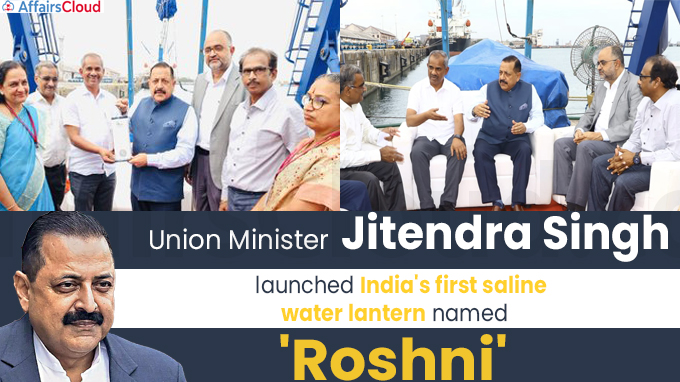
Dr. Jitendra Singh, Minister of State (Independent Charge), Ministry of Earth Science (MoES), has introduced “Roshni”, India’s first saline water lantern that uses seawater as an electrolyte between specially designed electrodes to power LED (Light Emitting Diode) lamps.
- The first-of-its-kind lantern was unveiled during his visit to the SAGAR ANVESHIKA, a Coastal Research Vessel operated and used for coastal research by the National Institute of Ocean Technology (NIOT), Chennai, Tamil Nadu.
Highlights of The ‘Roshni‘ Saline Water Lantern
i. Roshnisaline lantern would provide “ease of living” to the poor and needy, notably the fishing community living along India’s 7,500-kilometre (km) long coastal line, which is home to 9 coastal states and 1,382 islands.
- The saline lantern could be powered by any saline water or normal water mixed with common salt, making the technology feasible and affordable to use even in hinterlands where sea water is not available.
ii.The NIOT team was encouraged to perform Transfer of Technology (ToT) to industry for mass production of this multipurpose lamp, which can be of great help in rural and remote locations, as well as during disasters.
iii. Given that 30% of the population of India lives in coastal regions and that the country is surrounded by oceans on three sides, it is significant that coastal regions are important from an economical perspective.
- It promotes aquaculture, tourism, livelihood, and blue trade.
iv.The Saline Water Lantern will enhance the Indian government’s “UnnatJyoti by Affordable LEDs for All (UJALA) programme,” which was launched in 2015 to distribute LED bulbs across the country.
v.Roshini Lamps will support a vibrant Renewable Energy (RE) programme that aims to achieve energy security, energy access, and reduce the carbon footprint of the national economy, together with the Ministry of Power’s schemes like Solar Study Lamps.
Low Temperature Thermal Desalination (LTTD): A Technology to Convert Seawater to Potable Water
i. Jitendra Singh also reviewed the progress of NIOT’s Low Temperature Thermal Desalination (LTTD) technology for conversion of sea water to potable water (drinking water), which was successfully demonstrated in the Union Territory (UT) of Lakshadweep.
- Three desalination plants based on LTTD technology have been designed and demonstrated in the UT of Lakshadweep on the islands of Kavaratti, Agati, and Minicoy.
- Each of these LTTD plants has a daily capacity of 1 lakh litres of potable water.
ii.Based on the success of these plants, the Ministry of Home Affairs (MHA) has assigned the task of creating six more LTTD facilities with a total capacity of 1.5 lakh litres/day to UT of Lakshadweep.
- The LTTD plants in Lakshadweep would be built at a cost of Rs. 187.75 crore in Amini, Androth, Chetlet, Kadmat, Kalpeni, and Kiltan.
iii. The Lakshadweep islands are found to be suitable for the LTTD technology since the essential temperature difference of roughly 15 °C between sea surface water and deep – sea water can be found in the coastal areas.
Other Relevant Events
- Dr. Jitendra Singh and M. Ravichandran, Secretary of the MoES, visited the laboratories and hoisted the Indian flag on the vessel as part of the effort to extend the “Har Ghar Tiranga” campaign to the “Har Jahaj Tiranga.”
- He also reviewed the progress of the implementation of the Deep Ocean Mission of India.
Recent Related News:
The Indian Navy and the National Centre for Medium Range Weather Forecasting (NCMRWF) of the Ministry of Earth Sciences(MoES), signed a Memorandum of Understanding (MoU) for “Cooperation on Numerical Model-Based Applications in Meteorology and Oceanology.”
About Ministry of Earth Science (MoES):
Minister of State (Independent Charge) – Dr. Jitendra Singh (Udhampur Constituency, Jammu and Kashmir)
Subordinate Offices – Indian Meteorological Department (IMD), Delhi; National Centre for Medium Range Weather Forecasting (NCMRWF), Noida (Uttar Pradesh)




